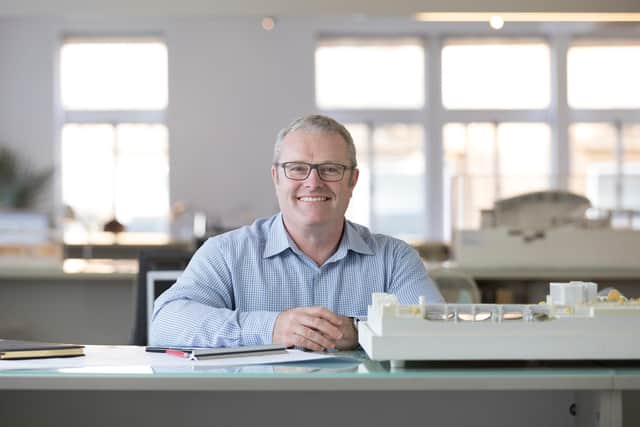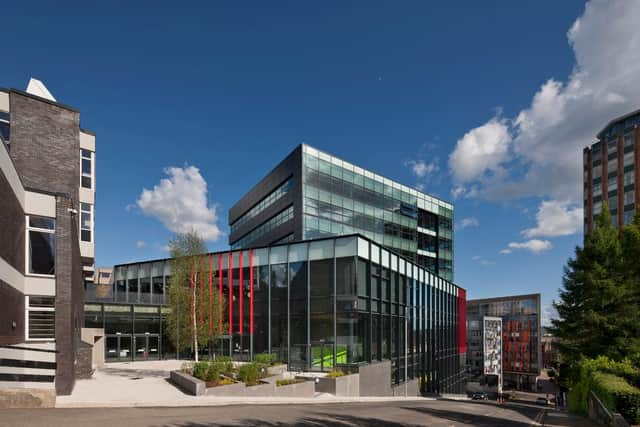The Big Interview: Scott Mackenzie, chair of BDP Scotland
BDP Scotland is part of globe-spanning group BDP – whose initials stand for Building Design Partnership, and which defines its offering as “architects, engineers, designers and urbanists”.
It was founded in 1961 by Professor Sir George Grenfell Baines (known as GG), who sought to establish the world’s first interdisciplinary practice.
Advertisement
Hide AdAdvertisement
Hide AdIts Scottish studio presence came into existence eight years later – the same year Mr Mackenzie was born – and the firm last year made a return to Edinburgh, with a new practice studio in the city centre complementing its presence in Glasgow, following the acquisition of Pattern Design.


BDP Scotland said in October that the move followed a “strong year of growth” as it achieved revenues of £131.3 million and expanded its presence in Northern Europe and South-east Asia. Mr Mackenzie joined the firm in 1999, and is also its architect principal and education sector leader.
Can you explain what BDP Scotland does, including key current and previous projects?
BDP is a major international practice of architects, designers, engineers and urbanists, with two Scottish studios – in Glasgow and Edinburgh. We bring a unique offer to the Scottish marketplace; international experience and global knowledge, but with a local perspective.
A great example of this is the St James Quarter, Edinburgh’s largest development in a generation, blending a new European-style galleria offering mixed uses, while respecting the sensitivities of a World Heritage Site.


Collectively, we offer experts spanning the spectrum of the built environment and sectors, including education, retail, workplace, transport, healthcare, stadia and mixed-use developments. Dumfries and Galloway College, Perth Concert Hall, Kelvingrove Art Gallery and Museum, Scottish Widows’ HQ, and the Glasgow Science Centre are just some of the Scottish projects we have delivered during my time at BDP.
This diverse capability offers great opportunities for our staff to work on national and global projects from our Scottish studios, including Google’s HQ in Kings Cross London, Heriot-Watt University’s Dubai Campus, and the Abu Dhabi Cruise Terminal.
Our user-centric approach to architecture, design and landscape architecture can be seen in our most recently completed projects including Glasgow Queen Street Station and Ayr Grammar, a multi-generational campus with a nursery, primary school, community arts centre, and a home for the Ayrshire Archives and Registry that houses the repositories for historical records and the Ayrshire fine art collection.
Advertisement
Hide AdAdvertisement
Hide AdThe firm last year resumed a presence in Edinburgh with the acquisition of Pattern Design – to what extent has that boosted/broadened activity? For example reinforcing its presence in the sport and stadia sector…
BDP’s offering, combined with Pattern’s stadia and arena design expertise, strengthens our capabilities. It offers opportunities for greater collaboration and cross-fertilisation between sectors to create the world’s most experiential and inspiring places to visit, watch, and support the best sporting action.
We are excited that our team is currently developing the new Bramley-Moore Dock Stadium for Everton FC, with main contractor Laing O’Rourke. This £500m, 52,890-seat venue is the centrepiece of the largest single-site private sector development in the UK. The scheme will act as the catalyst for the regeneration of the wider area.
The pandemic has emphasised the vital importance of preventative measures with regards to our health and wellbeing. With BDP Pattern’s expertise, BDP can be a champion of design that encourages wider participation in sport.
The diversity of sectors is also key to business resilience, and it provides lots of interesting opportunities for staff development and progression.
The deal also resulted in you leading both BDP’s Glasgow and Edinburgh studios. Can you give more details on what your own role entails, including a major focus on education...?
I joined BDP in 1999 and have been part of the director group that manages the studio since 2006. I am also BDP’s education sector leader, working across our global network of studios.
We have delivered multi-award winning projects including the Napier Business School in Edinburgh, the Saltire Centre at Glasgow Caledonian University, and the Technology and Innovation Centre at the University of Strathclyde.
Advertisement
Hide AdAdvertisement
Hide AdFollowing the acquisition of BDP Pattern last year, I welcomed the opportunity to expand my role to also lead the Edinburgh studio, working alongside architect director Lindsay Johnston and the 40-strong studio team, which has been designing stadia in Canada, Peru and the Middle East, including two FIFA World Cup stadia.
It is an exciting time for me to be leading and growing our diverse portfolio from Scotland, and this includes expanding our healthcare offering. BDP played a key role during the pandemic delivering the Nightingale hospitals at speed and scale, and we have also a successful track record in hospitals, research institutes, and community health campus delivery.
What attracted you to a career in architecture? Who are your favourite architects?
As a boy I enjoyed drawing, and architecture was a job where I would get paid to draw. I studied at the Scott Sutherland School of Architecture & Built Environment at what is now Robert Gordon University (RGU) in Aberdeen – which allowed me to head along to watch the football at Pittodrie whenever funds allowed.
Years later, BDP would design the new Scott Sutherland School as part of the transformation of RGU’s Garthdee Campus.
When it comes to design, I admire the work of Hans Wegner, Borge Mogensen, Ib Kofod Larsen, Poul Henningsen, Bruno Mathsson – designers (and occasional architects) who created household items of beauty and functionality that have timeless qualities.
How did BDP Scotland adapt to the challenges of the pandemic – such as builders having to down tools for prolonged periods? Did you have to furlough and/or lay off any staff?
There is no doubt that the lockdowns in 2020 were tough for the built environment sector. Some projects were unable to progress during this period due to the nature of the stage they were at, and as a result some staff members were furloughed.
Advertisement
Hide AdAdvertisement
Hide AdBut overall, the BDP team quickly adapted to the changes and there was a great deal of collaboration as we all worked to keep projects moving. Staff safety, health and wellbeing were paramount and we supported the team to quickly adapt to home working. The pandemic has transformed the way we work.
The company is very focused on sustainability, including adaptive reuse. Why is sustainability such a priority for you, and how is that helping Scotland reach its 2045 net-zero target?
The global climate crisis is at a critical point and is the greatest challenge that we face. Those involved in the construction and operation of buildings and infrastructure, which generate around a third of global carbon emissions, have not done enough in the past to tackle this. However, there is now a positive shift in mindset, and they are starting to grasp the magnitude of their responsibility.
BDP is actively engaged with industry to ensure that we are contributing to the national and global agenda, and that our design approach continues to deliver progressive, practical and financially sound solutions in response to environmental, social and economic challenges. We explore the big issues with our clients and consider all impacts of a project throughout to ensure we maximise the positive impact.
Our sustainability team sits at the heart of BDP, with expertise in life-cycle assessment, circular economy and resource management, energy and carbon consultancy and ecology services, as well as in bespoke development environmental strategies.
A great example of this is BDP’s design of the University of Strathclyde Learning and Teaching Building. A site options appraisal was undertaken, with the preferred option the adaptive re-use of the existing Colville and Architecture Buildings. The decision to transform the existing buildings rather than a new-build project has clear sustainable benefits – such as saving the same amount of carbon generated by 3,350 Scottish homes in one year.
What would you like BDP Scotland to look like in 2029 – exactly three decades after you joined?
Last year, BDP celebrated 60 years of operating as a people-focused practice with social purpose. And since 1969, we have had a studio presence in Scotland. As we move through the next decade, the vision for the Scottish studios is to continue to enhance the diversity of our sectors and innovation in our practice.
Advertisement
Hide AdAdvertisement
Hide AdWe recognise that the needs of towns and cities are changing as climate change and innovative technologies drive cultural and business needs. Sustainability will remain at the heart of our approach, collaborating with clients to deliver inclusive communities, innovative cities and people-centred places.
We have world-class experts working in Glasgow and Edinburgh who bring global knowledge and experience, but also understand the Scottish context, and this will support business growth.
You’ve said that in 2050, you expect the architecture profession to be much more “hectic and complex” than now – why do you believe this?
When I entered the profession we produced drawings with pens on drawing boards. This process took time and was a craft in itself. Communication was via letter, or if responses were more urgent, by phone or fax. The result was that the production of design information allowed for time to think, reflect and review.
While the introduction of new technologies delivers great benefits for our clients, today’s construction industry, with its expectations of fast delivery of vast quantities of information and instantaneous communication flows, adds pressure.
But hopefully, as technology becomes more intuitive, processes will become more straightforward, and my “hectic and complex” prediction will prove unfounded.
A message from the Editor:
Thank you for reading this article. We're more reliant on your support than ever as the shift in consumer habits brought about by coronavirus impacts our advertisers.
If you haven't already, please consider supporting our trusted, fact-checked journalism by taking out a digital subscription.
Comments
Want to join the conversation? Please or to comment on this article.
